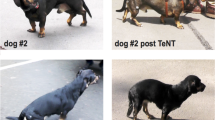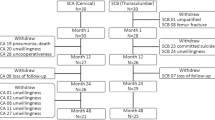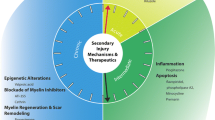Abstract
Purpose
To investigate the effect of an anti-TNF-α agent (etanercept) on recovery processes in a partial spinal cord injury (SCI) model using clinical and electrophysiological tests.
Methods
Twenty-four New Zealand rabbits were divided into three groups: group 1 [SCI + 2 ml saline intramuscular (i.m.), n = 8], group 2 (SCI + 2.5 mg/kg etanercept, i.m., 2–4 h after SCI, n = 8) and group 3 (SCI + 2.5 mg/kg etanercept, i.m., 12–24 h after SCI, n = 8). Rabbits were evaluated before SCI, immediately after SCI, 1 week after, and 2 weeks after SCI, clinically by Tarlov scale and electrophysiologically by SEP.
Results
Tarlov scores of groups 2 and 3 were significantly better than group 1, 2 weeks after SCI. SEP recovery was significantly better in groups 2 and 3 than group 1, 2 weeks after SCI.
Conclusions
These results show that blocking TNF-α mediated inflammation pathway by an anti-TNF-α agent enhances clinical and electrophysiological recovery processes in partial SCI model.

Similar content being viewed by others
References
Leal-Filho MB (2011) Spinal cord injury: from inflammation to glial scar. Surg Neurol Int 2:112. doi:10.4103/2152-7806.83732
Carmel JB, Galante A, Soteropoulos P, Tolias P, Recce M, Young W, Hart RP (2001) Gene expression profiling of acute spinal cord injury reveals spreading inflammatory signals and neuron loss. Physiol Genomics 7:201–213. doi:10.1152/physiolgenomics.00074.2001
Caminero A, Comabella M, Montalban X (2011) Tumor necrosis factor alpha (TNF-alpha), anti-TNF-alpha and demyelination revisited: an ongoing story. J Neuroimmunol 234:1–6. doi:10.1016/j.jneuroim.2011.03.004
McCoy MK, Tansey MG (2008) TNF signaling inhibition in the CNS: implications for normal brain function and neurodegenerative disease. J Neuroinflammation 5:45. pii: 1742-2094-5-45
Tracey D, Klareskog L, Sasso EH, Salfeld JG, Tak PP (2008) Tumor necrosis factor antagonist mechanisms of action: a comprehensive review. Pharmacol Ther 117:244–279. doi:10.1016/j.pharmthera.2007.10.001
Yang L, Lindholm K, Konishi Y, Li R, Shen Y (2002) Target depletion of distinct tumor necrosis factor receptor subtypes reveals hippocampal neuron death and survival through different signal transduction pathways. J Neurosci 22:3025–3032. pii: 20026317
Ferguson AR, Christensen RN, Gensel JC, Miller BA, Sun F, Beattie EC, Bresnahan JC, Beattie MS (2008) Cell death after spinal cord injury is exacerbated by rapid TNF alpha-induced trafficking of GluR2-lacking AMPARs to the plasma membrane. J Neurosci 28:11391–11400. doi:10.1523/JNEUROSCI.3708-08.2008
Hermann GE, Rogers RC, Bresnahan JC, Beattie MS (2001) Tumor necrosis factor-alpha induces cFOS and strongly potentiates glutamate-mediated cell death in the rat spinal cord. Neurobiol Dis 8:590–599. doi:10.1006/nbdi.2001.0414
Sobani ZA, Quadri SA, Enam SA (2010) Stem cells for spinal cord regeneration: current status. Surg Neurol Int 1:93. doi:10.4103/2152-7806.74240
Zalevsky J, Secher T, Ezhevsky SA, Janot L, Steed PM, O’Brien C, Eivazi A, Kung J, Nguyen DH, Doberstein SK, Erard F, Ryffel B, Szymkowski DE (2007) Dominant-negative inhibitors of soluble TNF attenuate experimental arthritis without suppressing innate immunity to infection. J Immunol 179:1872–1883. pii: 179/3/1872
Genovese T, Mazzon E, Crisafulli C, Di Paola R, Muia C, Bramanti P, Cuzzocrea S (2006) Immunomodulatory effects of etanercept in an experimental model of spinal cord injury. J Pharmacol Exp Ther 316:1006–1016. doi:10.1124/jpet.105.097188
Talac R, Friedman JA, Moore MJ, Lu L, Jabbari E, Windebank AJ, Currier BL, Yaszemski MJ (2004) Animal models of spinal cord injury for evaluation of tissue engineering treatment strategies. Biomaterials 25:1505–1510. pii: S0142961203004976
Tazegül T (2010) Tavşanda deneysel kısmi omurilik hasarı modelinin tanımlanması. Dissertation, Cumhuriyet Üniversitesi
Yıldız O (2008) Deneysel omurilik basısında riluzole ve magnezyum sülfat tedavisinin etkinliğinin MRG ve patolojik inceleme ile araştırılması. Dissertation, Cumhuriyet Üniversitesi
Chadi G, Andrade MS, Leme RJ, Gomide VC (2001) Experimental models of partial lesion of rat spinal cord to investigate neurodegeneration, glial activation, and behavior impairments. Int J Neurosci 111:137–165
Multon S, Franzen R, Poirrier AL, Scholtes F, Schoenen J (2003) The effect of treadmill training on motor recovery after a partial spinal cord compression-injury in the adult rat. J Neurotrauma 20:699–706. doi:10.1089/089771503767869935
Genovese T, Mazzon E, Crisafulli C, Esposito E, Di Paola R, Muia C, Di Bella P, Meli R, Bramanti P, Cuzzocrea S (2007) Combination of dexamethasone and etanercept reduces secondary damage in experimental spinal cord trauma. Neuroscience 150:168–181. doi:10.1016/j.neuroscience.2007.06.059
Marchand F, Tsantoulas C, Singh D, Grist J, Clark AK, Bradbury EJ, McMahon SB (2009) Effects of etanercept and minocycline in a rat model of spinal cord injury. Eur J Pain 13:673–681. doi:10.1016/j.ejpain.2008.08.001
Guven C, Borcek AO, Cemil B, Kurt G, Yildirim Z, Ucankus NL, Kilic N, Ceviker N (2010) Neuroprotective effects of infliximab in experimental spinal cord ischemic injury. J Clin Neurosci 17:1563–1567. doi:10.1016/j.jocn.2010.04.027
Kurt G, Ergun E, Cemil B, Borcek AO, Borcek P, Gulbahar O, Ceviker N (2009) Neuroprotective effects of infliximab in experimental spinal cord injury. Surg Neurol 71:332–336. doi:10.1016/j.surneu.2008.01.038 (discussion 336)
Agrawal G, Kerr C, Thakor NV, All AH (2010) Characterization of graded multicenter animal spinal cord injury study contusion spinal cord injury using somatosensory-evoked potentials. Spine (Phila, PA, 1976) 35:1122–1127. doi: 10.1097/BRS.0b013e3181be5fa7
Agrawal G, Sherman D, Maybhate A, Gorelik M, Kerr DA, Thakor NV, All AH (2010) Slope analysis of somatosensory evoked potentials in spinal cord injury for detecting contusion injury and focal demyelination. J Clin Neurosci 17:1159–1164. doi:10.1016/j.jocn.2010.02.005
Papakostas JC, Matsagas MI, Toumpoulis IK, Malamou-Mitsi VD, Pappa LS, Gkrepi C, Anagnostopoulos CE, Kappas AM (2006) Evolution of spinal cord injury in a porcine model of prolonged aortic occlusion. J Surg Res 133:159–166. doi:10.1016/j.jss.2005.10.007
Acknowledgments
This work is supported by the Scientific Research Project Fund of the Cumhuriyet University under project number T-475.
Conflict of interest
None.
Author information
Authors and Affiliations
Corresponding author
Additional information
F. Bayrakli, H. Balaban and U. Ozum contributed equally to the manuscript.
Rights and permissions
About this article
Cite this article
Bayrakli, F., Balaban, H., Ozum, U. et al. Etanercept treatment enhances clinical and neuroelectrophysiological recovery in partial spinal cord injury. Eur Spine J 21, 2588–2593 (2012). https://doi.org/10.1007/s00586-012-2319-7
Received:
Revised:
Accepted:
Published:
Issue Date:
DOI: https://doi.org/10.1007/s00586-012-2319-7




